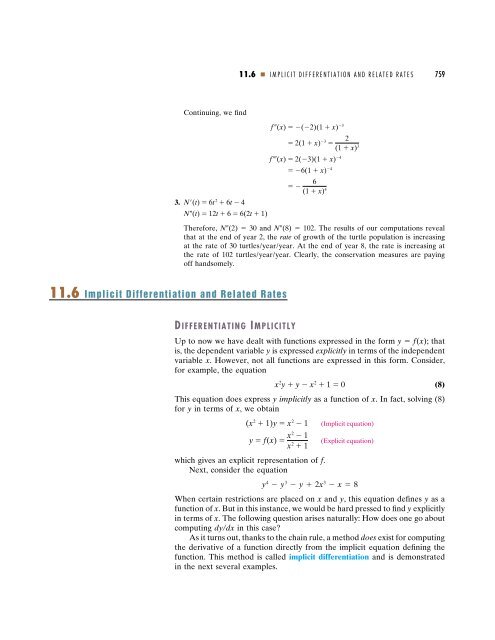11DIFFERENTIATION - Department of Mathematics
11DIFFERENTIATION - Department of Mathematics
11DIFFERENTIATION - Department of Mathematics
Create successful ePaper yourself
Turn your PDF publications into a flip-book with our unique Google optimized e-Paper software.
Continuing, we find<br />
3. N(t) 6t 2 6t 4<br />
N(t) 12t 6 6(2t 1)<br />
11.6 Implicit Differentiation and Related Rates<br />
11.6 IMPLICIT DIFFERENTIATION AND RELATED RATES 759<br />
f (x) (2)(1 x) 3<br />
2(1 x) 3 <br />
2<br />
(1 x) 3<br />
f (x) 2(3)(1 x) 4<br />
6(1 x) 4<br />
<br />
6<br />
(1 x) 4<br />
Therefore, N(2) 30 and N(8) 102. The results <strong>of</strong> our computations reveal<br />
that at the end <strong>of</strong> year 2, the rate <strong>of</strong> growth <strong>of</strong> the turtle population is increasing<br />
at the rate <strong>of</strong> 30 turtles/year/year. At the end <strong>of</strong> year 8, the rate is increasing at<br />
the rate <strong>of</strong> 102 turtles/year/year. Clearly, the conservation measures are paying<br />
<strong>of</strong>f handsomely.<br />
D IFFERENTIATING I MPLICITLY<br />
Up to now we have dealt with functions expressed in the form y f(x); that<br />
is, the dependent variable y is expressed explicitly in terms <strong>of</strong> the independent<br />
variable x. However, not all functions are expressed in this form. Consider,<br />
for example, the equation<br />
x2y y x2 1 0 (8)<br />
This equation does express y implicitly as a function <strong>of</strong> x. In fact, solving (8)<br />
for y in terms <strong>of</strong> x, we obtain<br />
(x2 1)y x2 1 (Implicit equation)<br />
y f(x) x2 1<br />
x 2 1<br />
(Explicit equation)<br />
which gives an explicit representation <strong>of</strong> f.<br />
Next, consider the equation<br />
y4 y3 y 2x3 x 8<br />
When certain restrictions are placed on x and y, this equation defines y as a<br />
function <strong>of</strong> x. But in this instance, we would be hard pressed to find y explicitly<br />
in terms <strong>of</strong> x. The following question arises naturally: How does one go about<br />
computing dy/dx in this case?<br />
As it turns out, thanks to the chain rule, a method does exist for computing<br />
the derivative <strong>of</strong> a function directly from the implicit equation defining the<br />
function. This method is called implicit differentiation and is demonstrated<br />
in the next several examples.

















